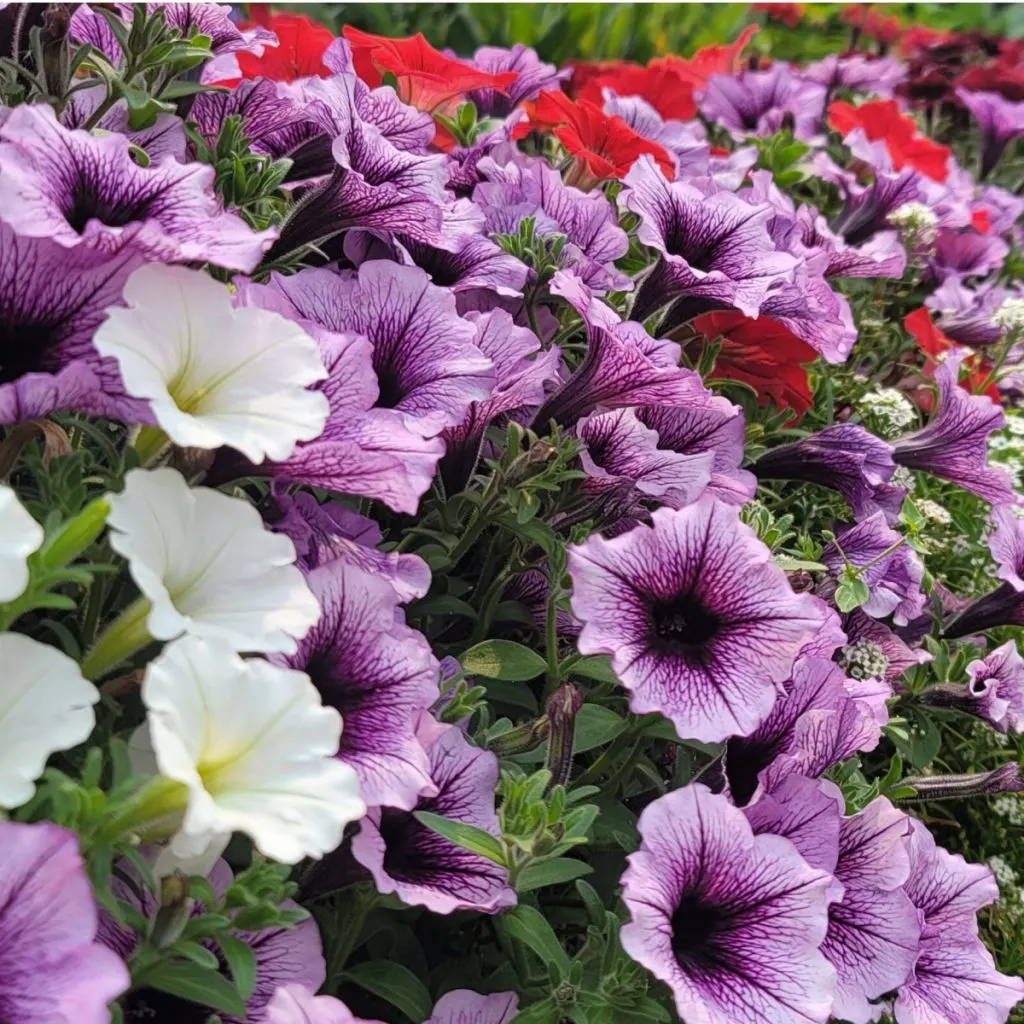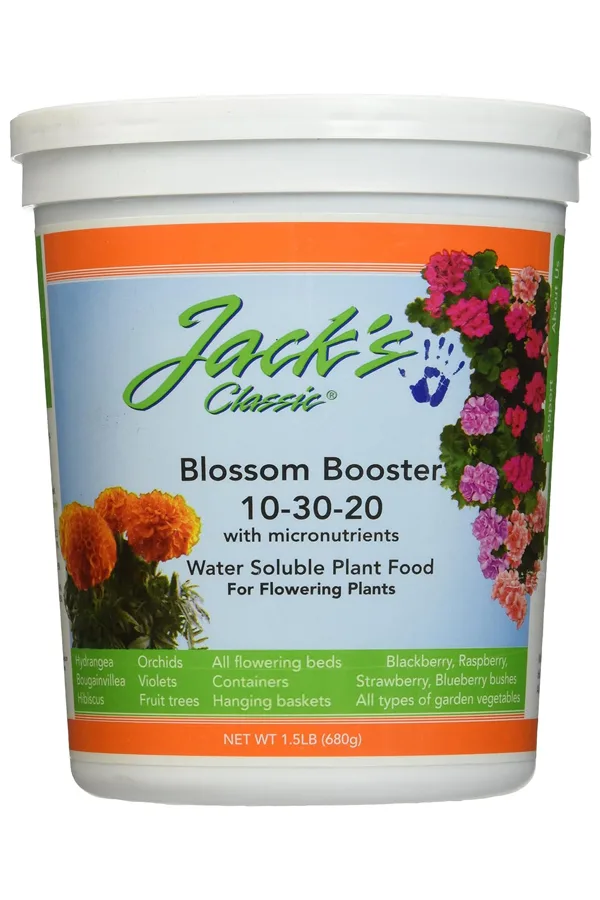Looking for the best way to fertilize and power your petunias this year to keep them growing strong and blooming all summer long?
Petunias are perfect for growing in containers, hanging baskets, window boxes, flowerbeds – or planting directly in the ground. They truly are one of the classic flowering annuals of summer. And with varieties available in nearly every color of the rainbow, they add classic elegance wherever they grow. Especially when they are loaded with blooms.
But if there is one thing gardeners struggle with when it comes to petunias, it’s keeping them blooming past the first few months of spring. Not only do they often begin to produce fewer and fewer blooms, by mid summer, for many, the plant’s foliage often becomes a tangled mess of dying stems and leaves.

But here’s the good news – by simply fertilizing your petunias with the right fertilizer and in the right amount – you can keep them flowering big right into late fall!
How To Fertilize Petunias – Keep Your Petunias Flowering All Summer Long!
Petunias naturally produce a steady stream of blooms. But to do that, it requires a large amount of nutrients. Petunias typically grow in containers and hanging baskets – where they have limited soil to find nutrients.
As the plants grow, they quickly deplete those resources to power growth and blooms. And without replacing those nutrients, they can quickly begin to struggle and fail. This is even true when petunias grow in flowerbeds where they can also quickly run out of the energy they need to bloom.
This, of course, is exactly where fertilizing can make all the difference. But it is all comes down to being able to give your petunias the right type of energy to help them stay strong – without giving them so much it can actually harm their overall health and blooming potential.
There are actually two big mistakes gardeners often make when fertilizing petunias. The first is giving them too large of a dose. The second is giving them the wrong type of nutrients for flowering.

By providing petunia plants with a large dose of fertilizer, chances are they will end up producing a lot of growth and perhaps even a large number of blooms in a short period of time. That sounds like a good thing, but unfortunately, it’s not.
Why? Because all of that fast growth creates an oversized plant with oversized roots – and one that can’t sustain its growth all season. Quite often, over-fertilizing will also cause plants to focus solely on creating foliage instead of blooms. In the end, you end up with a huge plant with little to no flowers!
Giving Petunias The Perfect Dose Of Power – How To Fertilize Petunias
The answer to it all is to give your petunias smaller doses of energy, but at a consistent pace. A low and slow pace truly is the first key to keeping your plants healthy and flowering at steady pace. This approach to fertilizing is actually great for all annual flowers – and vegetable plants too.
But at the same time, what you are feeding them matters as well. And this is where the second most common problem of giving petunias the wrong dose of nutrients comes into play.
Instead of selecting an all purpose balanced fertilizer with equal amount of nitrogen, phosphorous and potassium, it’s best to use a liquid fertilizer that has double or more of phosphorous and potassium versus the percentage of nitrogen.

This is because plants use nitrogen to grow foliage and stems – not blooms. And if you overfeed your plants with too much nitrogen, they will grow big and get dark green – but have little blooms. But by giving them more phosphorous and potassium, which happen to be the nutrients they need for blooming, you will get more flowers than ever – all while keeping your plant growing consistently!
Look for a liquid soluble fertilizer with a 10-30-20 or 5-15-10 ratio of nitrogen, phosphorous and potassium. This will work perfectly to power blooms – and not just growth. Affiliate Product Link: Jack’s Classic Blossom Booster 1.5 lbs, 10-30-20
Fertilizing For Success – How To Fertilize Petunias
Last but not least, how you apply the fertilizer is the final key to success. Instead of those big doses every three to four weeks, apply the fertilizer at half strength every 10 to 14 days. This will keep a steady stream of nutrients to your plants that will have them consistently flowering.
Finally, one last great way to add even more low and slow power is with worm castings. In addition to fertilizing, add one cup of worm castings to the soil around your plants every month. Every time you water your petunias, you will be giving the plants a light boost of nutrients as the water soaks through the castings. Affiliate Product Link: 100% Pure Worm Castings
Watering For Success
In addition to fertilizing, how you water your petunias can make a huge difference in blooming and plant health as well. Not only does the amount of water you use matter – but when and how you water them is equally important.
Potted or container plants tend to rely more on frequent watering than their in-ground counterparts. However, you also don’t want the plants to be sitting in constantly wet soil either. If you water your petunia plants too frequently, their roots can begin to rot, weakening the plants.
Yellowing foliage will often be your first sign of over-watering, while drying and shriveling foliage can indicate a lack of water. Both of these cause the roots to stop taking in nutrients as they either shrivel from drying out, or swell from being water logged.

How To Water Petunias Properly – How To Fertilize Petunias And Keep Them Blooming All Summer
As with all plants, checking your petunia plant’s soil prior to watering is the key to avoiding over-watering and underwatering.
Place your pointer finger down into the soil. If the soil is still moist (sticks to your finger) at around the one-inch mark, hold off on watering. But if the soil is dry, you’re plants need moisture. You can also use an inexpensive moisture meter to quickly tell you the soil’s moisture level.
Try to only water your petunia plants early in the morning. This will hydrate them early, allowing them to dry out slightly throughout the day. Also, avoid getting water in the trumpet-shaped blooms. This will cause the blooms to fade more quickly. Instead, water plants at the base underneath the blooms if possible.
Finally, water container plants deeply until you start to see water seeping out of the drainage holes. This promotes plants to grow deep roots, creating sturdier and stronger plants.
Deadheading – How To Fertilize Petunias And Keep Them Blooming All Summer
Last but not least, the final secret to keeping your petunias flowering strong from summer through fall is deadheading spent blooms. And yes, it really does make a BIG difference!

As old blooms start to die off, they will shrivel up and their color starts to fade. These spent blooms don’t look the best on plants, but there is more to it than just appearances. Dying blooms are still using up nutrients and resources from the plant’s soil.
Unfortunately, the plants will continue to send resources to the blooms instead of focusing on creating new blooms as long as they remain. And that is exactly why removing them can help your plant conserve that energy to use instead for new blooms!
How To Deadhead Petunias – How To Fertilize Petunias And Keep Them Blooming All Summer
Thankfully, deadheading (removing spent flowers) is not only easy, but quite a quick chore to perform as well. There are a few pointers though when deadheading that can help your plants bloom out more quickly.
While it might seem like you can just pull the petals off of the plant because they dislodge so easily when they are fading, that can leave behind the seed head. You actually need to pinch off right below the seed head, taking it and the petals off of the plant entirely.
You can easily just use your fingernails to snap off the delicate stems. Deadheading plants once every couple of days is perfect for allowing plants to focus their energy on creating new blooms instead of repairing dying ones. For more petunia TLC tips, see: How To Bring Your Petunias Back To Life – And Blooming Big Once Again!
Here is to fertilizing your petunias for success – and to keeping them blooming all summer long! For more on keeping your flowers in bloom, check out our article 3 Simple Secrets To Keep Hanging Baskets Blooming Big.
Simple Garden Life
Follow Our Facebook Page For Even More Great Tips! Simple Garden Life Facebook Page
Simple Garden Life is a website dedicated to keeping gardening fun, simple and enjoyable! We publish two new articles each week along with a new garden podcast episode every two weeks. This article may contain affiliate links.
